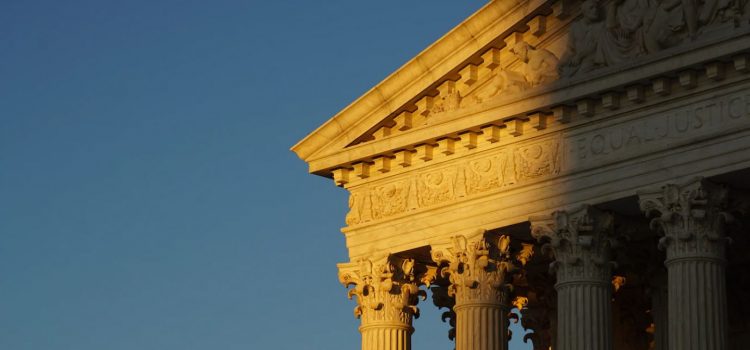
This is a free excerpt from one of Shortform’s Articles. We give you all the important information you need to know about current events and more.
Don't miss out on the whole story. Sign up for a free trial here .
Why should the United States reform the Supreme Court? What are the three possible reformation strategies?
Recently, several of the Supreme Court’s decisions have left many Americans to question whether the institution is still non-partisan. To stop the Supreme Court from overstepping its power, many are pushing for a Supreme Court reform.
Here’s a look at the most common arguments for reforming the Supreme Court, and the strategies that could be used to carry it out.
Reforming the U.S. Supreme Court
In the wake of the Supreme Court’s decision overturning Roe v. Wade, many people are calling for reform to counter what they view as the court’s increasingly partisan bent. They feel the court’s recent rulings on abortion, gun control, and voting rights, and its hints that it might want to overturn established rulings on contraception and same-sex marriage, show that it’s overstepped its mandate, is no longer a non-partisan body, and needs to be brought back into alignment with the wishes of the majority of Americans.
In this article, we’ll take a look at the cases for the reform of the Supreme Court.
The Case for Reform
The leading argument for reform holds that the Court’s decisions have grown out of step with the desires of the majority of Americans, and thus the Court no longer fulfills the role the Founding Fathers intended for it.
Proponents of reform acknowledge that the Founding Fathers designed the Court to withstand public pressure—for example, the lifetime tenure provision was intended to protect Justices from administrations that may not agree with them—but they contend that the Court has become so out of step with public wishes that it’s become an actively anti-democratic body, regularly upholding laws that run counter to the will of the majority. Therefore, instead of functioning as a check on political trends, it’s become a political influencer itself, which is inherently at odds with the intentions of the Founding Fathers.
Advocates for reform note that five of the six conservative Justices on the current Court—the majority of the Court—were appointed by presidents who lost the popular vote (George W. Bush and Donald Trump) and were confirmed by a Senate that more heavily weights the desires of states with smaller populations (currently, the Senate is split evenly in half, but Democrats represent 185 million voters while Republicans represent 143 million voters).
They argue that the minority rule in this dynamic contradicts the Founders’ democratic ideals. They also note another danger: It can tempt the Court to “place their thumb on the scale” and uphold laws that could help a minority party cling to power—for example, by ruling in favor of highly manipulated and gerrymandered voting districts.
Reform advocates further note that a Court that appears to be politically motivated has less legitimacy in the public’s eye. The danger, should the public grow to view the Court as illegitimate, is that people might, en masse, purposefully stop adhering to its rulings. Such a change would gravely test the country’s legal system.
Proposals for Reform
Beyond the debate over whether the Court should be reformed, there’s debate on how it might be reformed. Advocates for reform typically propose one of three strategies:
- Expanding the Court
- Establishing term limits
- Regularizing appointments
We’ll explore the discussions around each approach below.
The Case for Expanding the Court
The first approach to reforming the Supreme Court, and one that’s received much attention lately, is increasing the number of Justices (often referred to as “packing” the Court). Many advocates of this reform want the Biden administration to immediately add four seats to the Court, raising the total from nine to 13 and turning the current six-member Republican-appointed majority into a 6-7 minority.
Proponents of this approach say it will immediately fix the political imbalance of the Court and that it would be a justifiable intervention given how wildly the Court differs from the electorate on many issues. They argue that the current partisanship is so entrenched that it can only be fixed through dramatic, systemic change, and without this kind of move, the country will remain under minority rule for the next few generations at least.
They note, further, that the move would be both legal and with precedent: The Constitution doesn’t specify how many Justices should sit on the Court, and over the years, Congressional law has set the number at six, nine, five, seven, and 10, before President Ulysses S. Grant settled on nine for a final time in 1869 (for unclear reasons).
The Case for Term Limits
Another approach would be to limit the length of time each Justice serves. The Supreme Court is almost unique among courts, both domestically and globally, in appointing judges to life tenures. Among U.S. state courts, only Rhode Island doesn’t impose either term limits or a mandatory retirement age on its judges, and among major constitutional democracies, the U.S. is the only one that doesn’t do the same.
Advocates of term limits (most of whom recommend 18-year terms) argue that limiting the time Justices serve would make Supreme Court appointments less of a political prize: It would reduce the incentive for presidents to appoint young, ideological Justices who could stay on the court for decades and drive it in a predetermined political direction. This would help to decouple the Court from elections, making it more independent.
Proponents say that term limits would also prevent the political maneuvering that currently accompanies appointments. It would reduce the incentive for a Justice to retire based on political calculations so that a particular president can fill their spot—as illustrated by Democratic pressure on Ruth Bader Ginsburg to retire during President Obama’s administration so he could fill her spot. And it would preclude either party from delaying or rushing appointments according to how it might benefit them politically—as some accused the Republican party of doing when it refused to confirm Merrick Garland, an Obama nominee, during an election year but then fast-tracked the confirmation of Trump nominee Amy Coney Barrett during the 2020 election year.
Essentially, advocates say, term limits would make the appointment process fairer. If terms expired in a regular rotation, appointments could be more evenly and predictably spaced among different administrations, ultimately making the Court more politically balanced. Advocates note that term limits wouldn’t necessarily create a bipartisan court—if one party wins more elections, it will appoint more Justices. But the system would ensure a court that more accurately reflects the wishes of the populace as expressed through elections.
The Case for Term Appointments
A less-frequently discussed idea, but one that has some ardent supporters, focuses not on the retirement of Justices but instead on their appointment. In this system, every administration would get to nominate one Justice, regardless of the current makeup of the court. This means that the number of Justices would fluctuate: It might increase if Justices are added before others retire, but conversely, if Justices retire or die between scheduled appointments, their spot would remain open until after the next election cycle.
According to proponents, this type of system would have the benefits of a term-limit system while avoiding some of its potential problems. It would make the appointment process fairer and more predictable: Many observers note that there’s no justification for the randomness of the current system that might allow one president three or more nominations and another, zero. And, because it would allow Justices to serve as long as they wish, it would reduce their incentive to audition for their next job with legal opinions favorable to potential employers.
Further, because appointments would be non-negotiably regular, Justices would have zero incentive to retire early and hand an appointment to a favored administration.
Final Words
Of the three proposed reforms, the term limits idea has the most traction. It has bipartisan support among legislatures, think tanks, academic experts, and several of the Justices themselves.
Expanding the court has gained a lot of attention from advocacy groups, but few high-level legislators publicly support the idea. Notably, President Biden himself has long opposed it.
In 2021, President Biden put together a commission to examine the merits and methods of Supreme Court reform. The Commission’s findings were consistent with the above trends: It didn’t recommend whether or not to expand the court, instead limiting its discussion to laying out the pros and cons, but it did come out more strongly in favor of term limits.
Do you think it’s time for a Supreme Court reform, or do you think it’s doing the job that the Founding Fathers intended? Let us know in the comments.

Want to fast-track your learning? With Shortform, you’ll gain insights you won't find anywhere else .
Here's what you’ll get when you sign up for Shortform :
- Complicated ideas explained in simple and concise ways
- Smart analysis that connects what you’re reading to other key concepts
- Writing with zero fluff because we know how important your time is






